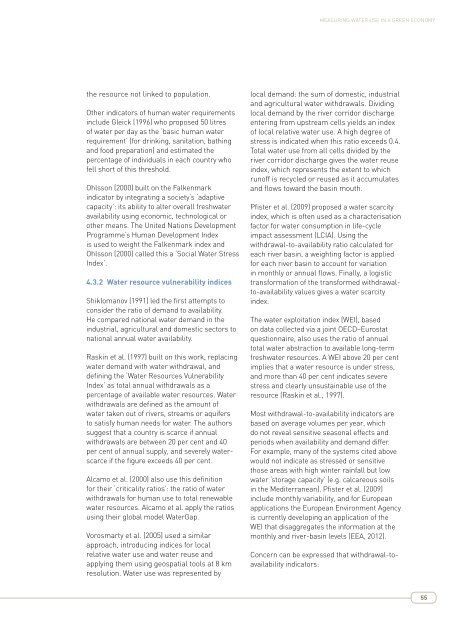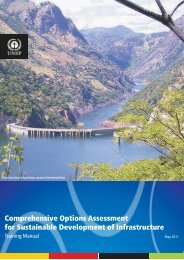MEASURING WATER USE IN A GREEN ECONOMY - UNEP
MEASURING WATER USE IN A GREEN ECONOMY - UNEP
MEASURING WATER USE IN A GREEN ECONOMY - UNEP
Create successful ePaper yourself
Turn your PDF publications into a flip-book with our unique Google optimized e-Paper software.
Measuring water use in a green economy<br />
the resource not linked to population.<br />
Other indicators of human water requirements<br />
include Gleick (1996) who proposed 50 litres<br />
of water per day as the ‘basic human water<br />
requirement’ (for drinking, sanitation, bathing<br />
and food preparation) and estimated the<br />
percentage of individuals in each country who<br />
fell short of this threshold.<br />
Ohlsson (2000) built on the Falkenmark<br />
indicator by integrating a society’s ‘adaptive<br />
capacity’: its ability to alter overall freshwater<br />
availability using economic, technological or<br />
other means. The United Nations Development<br />
Programme’s Human Development Index<br />
is used to weight the Falkenmark index and<br />
Ohlsson (2000) called this a ‘Social Water Stress<br />
Index’.<br />
4.3.2 Water resource vulnerability indices<br />
Shiklomanov (1991) led the first attempts to<br />
consider the ratio of demand to availability.<br />
He compared national water demand in the<br />
industrial, agricultural and domestic sectors to<br />
national annual water availability.<br />
Raskin et al. (1997) built on this work, replacing<br />
water demand with water withdrawal, and<br />
defining the ‘Water Resources Vulnerability<br />
Index’ as total annual withdrawals as a<br />
percentage of available water resources. Water<br />
withdrawals are defined as the amount of<br />
water taken out of rivers, streams or aquifers<br />
to satisfy human needs for water. The authors<br />
suggest that a country is scarce if annual<br />
withdrawals are between 20 per cent and 40<br />
per cent of annual supply, and severely waterscarce<br />
if the figure exceeds 40 per cent.<br />
Alcamo et al. (2000) also use this definition<br />
for their ‘criticality ratios’: the ratio of water<br />
withdrawals for human use to total renewable<br />
water resources. Alcamo et al. apply the ratios<br />
using their global model WaterGap.<br />
Vorosmarty et al. (2005) used a similar<br />
approach, introducing indices for local<br />
relative water use and water reuse and<br />
applying them using geospatial tools at 8 km<br />
resolution. Water use was represented by<br />
local demand: the sum of domestic, industrial<br />
and agricultural water withdrawals. Dividing<br />
local demand by the river corridor discharge<br />
entering from upstream cells yields an index<br />
of local relative water use. A high degree of<br />
stress is indicated when this ratio exceeds 0.4.<br />
Total water use from all cells divided by the<br />
river corridor discharge gives the water reuse<br />
index, which represents the extent to which<br />
runoff is recycled or reused as it accumulates<br />
and flows toward the basin mouth.<br />
Pfister et al. (2009) proposed a water scarcity<br />
index, which is often used as a characterisation<br />
factor for water consumption in life-cycle<br />
impact assessment (LCIA). Using the<br />
withdrawal-to-availability ratio calculated for<br />
each river basin, a weighting factor is applied<br />
for each river basin to account for variation<br />
in monthly or annual flows. Finally, a logistic<br />
transformation of the transformed withdrawalto-availability<br />
values gives a water scarcity<br />
index.<br />
The water exploitation index (WEI), based<br />
on data collected via a joint OECD–Eurostat<br />
questionnaire, also uses the ratio of annual<br />
total water abstraction to available long-term<br />
freshwater resources. A WEI above 20 per cent<br />
implies that a water resource is under stress,<br />
and more than 40 per cent indicates severe<br />
stress and clearly unsustainable use of the<br />
resource (Raskin et al., 1997).<br />
Most withdrawal-to-availability indicators are<br />
based on average volumes per year, which<br />
do not reveal sensitive seasonal effects and<br />
periods when availability and demand differ.<br />
For example, many of the systems cited above<br />
would not indicate as stressed or sensitive<br />
those areas with high winter rainfall but low<br />
water ‘storage capacity’ (e.g. calcareous soils<br />
in the Mediterranean). Pfister et al. (2009)<br />
include monthly variability, and for European<br />
applications the European Environment Agency<br />
is currently developing an application of the<br />
WEI that disaggregates the information at the<br />
monthly and river-basin levels (EEA, 2012).<br />
Concern can be expressed that withdrawal-toavailability<br />
indicators:<br />
55

















